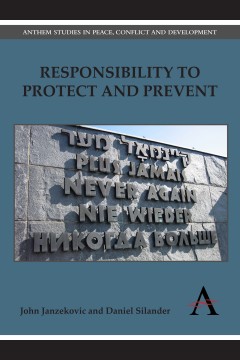Responsibility to Protect and Prevent
Principles, Promises and Practicalities
By John Janzekovic & Daniel Silander
- About This Book
- Reviews
- Author Information
- Series
- Table of Contents
- Links
- Podcasts
About This Book
If governments and policymakers agree on the principles of responsibility to protect (R2P), then why do they continue to ignore them and deal with violations of human rights ineffectively? ‘Responsibility to Protect and Prevent: Principles, Promises and Practicalities’ explores the evolution of R2P, a principle which – according to its supporters – has evolved into a new type of responsive norm for how the international community should react to serious and deliberate human rights violations. Arguing that the R2P ethos has been misunderstood and used ineffectively, this work defends the validity of R2P and urges for a more practical understanding that moves beyond theory.
The progression of R2P from an initial concept to formal ratification has been a very difficult one, with a great deal of disagreement over its validity as a substantive norm in international affairs. The disagreement is not that protection or prevention are unimportant, nor that the international community does not have at least some responsibility to try to stop extreme human rights violations. Rather, it is primarily about how the fine-sounding R2P principles are supposed to work in practice, and the utility of such principles when governments and policymakers continue to ignore the basic premise of protection.
This volume presents a number of important arguments that are directly related to the state vs. human security debate, with a critical analysis of the nexus between the protection verses prevention theses Through the case study of the Libyan Crisis, Janzekovic and Silander offer an example of the discrepancy and confusion regarding how R2P should be applied in practice, and support the claim that prevention should be more than an adjunct to protection.
Reviews
‘Strongly grounded in contemporary theorizing on human security, this thoughtful, persuasive book presents a tightly argued and concise case for a more developed, humane and preemptive approach to the problems of large-scale violence and human security.’ —R. E. Elson, Emeritus Professor of History, University of Queensland
‘The argument of Janzekovic and Silander’s timely book is compelling: a focus on future-oriented prevention is far more desirable than the pyrrhic military victories that ultimately fail to protect those most at risk. The work is written in a lucid and erudite way, and will be essential reading for both policymakers and scholars of international relations.‘ —Craig McLean, Senior Lecturer in Politics, Northumbria University
‘Practitioners and theoreticians must still wrestle with the real-world applications of the responsibility to protect doctrine; what Janzekovic and Silander propose may seem straightforward, but the literature to date has not approached R2P in this manner, and that’s what makes this study particularly important.’ —Kirsten Nakjavani Bookmiller, Professor of Government and Political Affairs, Millersville University of Pennsylvania
‘The book’s practical approach and focus on what can be done rather than what cannot regarding the responsibility to protect and prevent makes it useful and informative for the student and the practitioner alike.’ —Hans Lödén, Associate Professor of Political Science, Karlstad University, Sweden
Author Information
John Janzekovic is a lecturer in politics and international relations at the University of the Sunshine Coast, Queensland, Australia.
Daniel Silander is associate professor in the Department of Political Science at Linnaeus University, Sweden.
Series
Anthem Studies in Peace, Conflict and Development
Table of Contents
List of Maps; List of Abbreviations; Chapter 1: Introduction; Chapter 2: State versus Human Security: The Great Debate; Chapter 3: Responsibility: Protection and Prevention; Chapter 4: State Responsibility, Human Security and International Law; Chapter 5: Promoting Democratic Norms for Protection and Prevention Libya: Moving Principle into Action?; Chapter 7: Conclusion; Appendix I: S/RES/1970 United Nations Resolution 1970 on Africa (Including Annexes I–II); Appendix II: S/RES/1973 United Nations Resolution 1973 on the Situation in Libya (Excluding Annexes I–II); Notes; Bibliography; Index
Links
Stay Updated
Information
Latest Tweets



